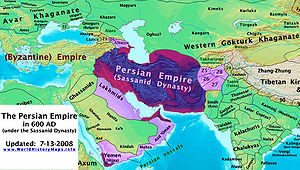- Tylos
-

This article is part of the series on:
Ancient Bahrain Dilmun Tylos and Mishmahig Awal Historical region Islam in Bahrain Al-Ala'a Al-Hadrami Qarmatians Usfurid dynasty Jarwanid dynasty Jabrid dynasty Portuguese occupation Muqrin ibn Zamil Antonio Correia Safavid hegemony (1602-1717) 1717 Oman invasion of Bahrain Al Khalifa and
the British Protectorate1783 Al Khalifa invasion of Bahrain Perpetual Truce of Peace
and Friendship (1861)First Oil Well (1932) 20th Century Bahrain National Union Committee March 1965 Intifada State Security Law era 1981 coup d'état attempt 1990s Uprising 2011 Uprising Topical Military history of Bahrain Timeline of Bahrain history Bahrain was referred to by the Greeks as Tylos, the centre of pearl trading, when Nearchus came to discover it serving under Alexander the Great.[1] From the 6th to 3rd century BC Bahrain was included in Persian Empire by Achaemenians, an Iranian dynasty.[2] The Greek admiral Nearchus is believed to have been the first of Alexander's commanders to visit this islands, and he found a verdant land that was part of a wide trading network; he recorded: “That in the island of Tylos, situated in the Persian Gulf, are large plantations of cotton tree, from which are manufactured clothes called sindones, a very different degrees of value, some being costly, others less expensive. The use of these is not confined to India, but extends to Arabia.”[3] The Greek historian, Theophrastus, states that much of the islands were covered in these cotton trees and that Tylos was famous for exporting walking canes engraved with emblems that were customarily carried in Babylon.[4]
It is not known whether Bahrain was part of the Seleucid Empire, although the archaeological site at Qalat Al Bahrain has been proposed as a Seleucid base in the Persian Gulf.[5] Alexander had planned to settle the eastern shores of the Persian Gulf with Greek colonists, and although it is not clear that this happened on the scale he envisaged, Tylos was very much part of the Hellenised world: the language of the upper classes was Greek (although Aramaic was in everyday use), while Zeus was worshipped in the form of the Arabian sun-god Shams.[6] Tylos even became the site of Greek athletic contests.[7]
The name Tylos is thought to be a Hellenisation of the Semitic, Tilmun (from Dilmun).[8] The term Tylos was commonly used for the islands until Ptolemy’s Geographia when the inhabitants are referred to as 'Thilouanoi'.[9] Some place names in Bahrain go back to the Tylos era, for instance, the residential suburb of Arad in Muharraq, is believed to originate from "Arados", the ancient Greek name for Muharraq island.[10]
The ancient Greeks speculated as to whether the Phoenicians were originally from Tylos. According to the 19th century German classicist, Arnold Heeren: “In the Greek geographers, for instance, we read of two islands, named Tyrus or Tylos, and Aradus, which boased that they were the mother country of the Phoenicians, and exhibited relics of Phoenician temples.”[11] The people of Tyre in particular have long maintained Persian Gulf origins, and the similarity in the words “Tylos” and “Tyre” has been commented upon.[12]
With the waning of Seleucid Greek power, Tylos was incorporated into Characene or Mesenian, the state founded in what today is Kuwait by Hyspaosines in 127BC. A building inscriptions found in Bahrain indicate that Hyspoasines occupied the islands, (and it also mention his wife, Thalassia). From the third century BC to arrival of Islam in the seventh AD, Bahrain was controlled by two other Iranian dynasties of Parthians and Sassanids.
By about 250 BC, Seleucids lost their tritories to Parthians, an Iranian tribe from Central Asia. Parthian dynasty brought the Persian Gulf under their control and extended their influence as far as Oman. Because they needed to control the Persian Gulf trade route, the Parthians established garrisons in the southern coast of Persian Gulf.[13]
In the third century AD, the Sasanids succeeded the Parthians and held area until the rise of Islam four centuries later.[13] Ardashir, the first ruler of Iranian Sassanians dynasty marched forward Oman and Bahrain and defeat Sanatruq [14] (or Satiran[2]), probably the Parthian governor of Bahrain.[15] He appointed his son Shapur I as governor of Bahrain. Shapur constructed a new city there and named it Batan Ardashir after his father.[2] At this time, Bahrain incorporated in the southern Sassanid province covering over the Persian Gulfs southern shore plus the archipelago of Bahrain.[15] The southern province of Sasanids was subdivided into three districts of Haggar (Now al-Hafuf province, Saudi Arabia), Batan Ardashir( Now al-Qatif province, Saudi Arabia), and Mishmahig (Now Bahrain Island) [2] (In Middle-Persian/Pahlavi means "ewe-fish".[16]) included the Bahrain archipelago which earlier called Aval, but later, in the Islamic era, became known as Bahrain.[2][15] The name 'ewe-fish' would appear to suggest that the name /Tulos/ is related to Hebrew /ṭāleh/ 'lamb' (Strong's 2924).[17]
By the fifth century Bahrain was a centre for Nestorian Christianity, with Samahij[18] the seat of bishops. In 410, according to the Oriental Syriac Church synodal records, a bishop named Batai was excommunicated from the church in Bahrain.[9] It was also the site Bahrain of worship of a shark deity called Awal. Worshippers reputedly built a large statue to Awal in Muharraq, although it has now been lost, and for many centuries after Tylos, the islands of Bahrain were known as ‘Awal’.
References
- ^ Life and Land Use on the Bahrain Islands: The Geoarcheology of an Ancient ... By Curtis E. Larsen p. 13
- ^ a b c d e Security and Territoriality in the Persian Gulf: A Maritime Political Geography By Pirouz Mojtahed-Zadeh, page 119
- ^ Arnold Hermann Ludwig Heeren, Historical Researches Into the Politics, Intercourse, and Trade of the Principal Nations of Antiquity, Henry Bohn, 1854 p38
- ^ Arnold Heeren, ibid, p441
- ^ Classical Greece: Ancient histories and modern archaeologies, Ian Morris, Routledge, p184
- ^ Phillip Ward, Bahrain: A Travel Guide, Oleander Press p68
- ^ W. B. Fisher et al. The Cambridge History of Iran, Cambridge University Press 1968 p40
- ^ Jean Francois Salles in Traces of Paradise: The Archaeology of Bahrain, 2500BC-300AD in Michael Rice, Harriet Crawford Ed, IB Tauris, 2002 p132
- ^ a b Jean Francois Salles p132
- ^ Curtis E. Larsen. Life and Land Use on the Bahrain Islands: The Geoarchaeology of an Ancient Society University Of Chicago Press, 1984 p13
- ^ Arnold Heeren, p441
- ^ Michael Rice The Archaeology of the Arabian Gulf Routledge 1994 p20
- ^ a b Bahrain By Federal Research Division, page 7
- ^ Robert G. Hoyland, Arabia and the Arabs: From the Bronze Age to the Coming of Islam, Routledge 2001p28
- ^ a b c Conflict and Cooperation: Zoroastrian Subalterns and Muslim Elites in ... By Jamsheed K. Choksy, 1997, page 75
- ^ Yoma 77a and Rosh Hashbanah, 23a
- ^ Strong's Hebrew and Aramaic Dictionary of Bible Words
- ^ From Persian sa-mahij (سه ماهی) meaning Three Fishes.
Categories:
Wikimedia Foundation. 2010.

